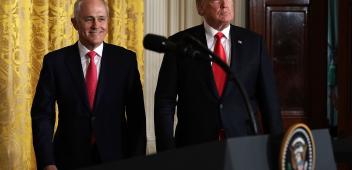Our toughest job lies ahead
It is five months since the last reported Covid-related death in Australia. But it is how we handle unemployment that will be one of the most critical issues. Originally published in The Australian.

Much earlier and in much better shape than expected, Australia is emerging from the most alarming public health shock most of us have experienced.
It is five months since the last reported COVID-19 related death in Australia and several months since any serious community transmission of the disease. In a few more weeks the most vulnerable among us will have been vaccinated. By October, we are promised, we will all have had at least one shot of vaccine, and most two. For some time to come Australians will not be able to travel abroad freely and people abroad will not be permitted to travel here freely. There will be scattered new infections and perhaps more deaths. But after a year of troubles the pandemic is pretty much over for Australians.
The pandemic was not only a health emergency but for two-thirds of us it was also the first economic slump in our working lives. The 29-year upswing — which had more than doubled Australia’s gross domestic product, increased average incomes by two-thirds, led to an eightfold increase in household wealth and a population increase of one-third, added more than four million jobs and recorded the highest share of Australians in the workforce — stopped abruptly when the pandemic reached us last year.
The slump, too, is over. A year ago Treasury officials contemplated a collapse in Australian output of one-fifth, a contraction that would have led to skyrocketing unemployment. Instead, by February this year the number of jobs was back to the level reached before the pandemic. After a rapid increase in output in the last quarter of last year it is likely that quarterly output is now above where it was before the pandemic — and higher than it has ever been.
A year ago Australia’s stockmarket had fallen by a third from its February high. By late last week it was back within a few per cent of its highest level. On the latest numbers Australian household wealth today is higher than it was before the pandemic.
This week Josh Frydenberg turned off JobKeeper, the biggest spending program adopted to meet the crisis and part of the greatest government spending expansion since the bleakest days of the Pacific War nearly 80 years ago. By the time the Treasurer brings down the next budget his attention will have turned from the pandemic to the future course of the Australian economy and from spending to saving.
Yet while the pandemic and the accompanying economic emergency are ending, Australia is in circumstances that are much different from those of a year ago. The country and the world have changed. The way Australia works has altered in enduring ways.
I discuss many of these changes in Reconstruction: Australia After COVID, my Penguin Special/Lowy Institute paper launched by former Reserve Bank of Australia governor Glenn Stevens this week.
One of the biggest and most critical issues, one already transforming the political debate, is how we handle unemployment.
Joblessness is the most debilitating of the lingering effects of the pandemic. While the number of jobs was almost back to pre-pandemic levels in February, the number of unemployed was still 109,500 higher than it was a year before. When it ceases, Treasury estimates that more than 100,000 people of the million or so still benefiting from the JobKeeper subsidy may lose their jobs.
Getting unemployment down is now the central task of government and the battleground of politics. It will be all the more enduring a battleground because the RBA’s objective is not just to bring down unemployment and underemployment to the rates reached at the end of the long boom but to reduce them well below it. Judging from remarks of Treasury secretary Steven Kennedy, the new RBA target of 4.5 per cent unemployment (or less) is shared by Treasury. Opposition Treasury spokesman Jim Chalmers has declared that the unemployment rate should have a four in front rather than a five. Though cautious, the Morrison government may find the pressure to adopt a markedly lower unemployment target irresistible.
It is a formidable objective with far-reaching consequences. It is 13 years since Australia last experienced such a low unemployment rate. To have reached 4.5 per cent unemployment in February, for example, we would have needed not just 110,000 additional jobs but closer to 200,000 additional jobs. From where we are now to where we want to go is roughly twice the distance as merely getting back to where we were before. Add another 100,000 jobs for those who may lose theirs with the end of JobKeeper and the shortfall is 300,000 jobs. To reach the 4.5 per cent unemployment target within, say, five years Australia will have to grow faster than before the pandemic and without interruption.
At the same time Australian government debt is on course to double, narrowing political options for the government and its Labor opponent and changing the character of the political debate.
With more ambitious goals, with colossal unexpected government debt, the RBA and Treasury have bigger and more difficult roles to play in the years to come.
Responding to the pandemic the RBA bought bonds and other financial assets, driving the bond rate lower than it would otherwise be and taking on to its balance sheet a large proportion of new debt issued by the commonwealth. Since the pandemic began the RBA has more than trebled its holding of Australian dollar assets, mainly though not only Australian government bonds. The increase in its holdings of Australian dollar assets is equivalent to about three-quarters of the additional debt of the commonwealth since the pandemic began.
The customary decision of the RBA board at the end of its monthly meetings, evident always in the final lines of the published meeting synopsis, was to raise the cash rate, lower it or leave it unchanged. Now for the first time in contemporary monetary policy practice the RBA has the means and the obligation to influence long-term rates as well as the cash rate. It influences the ease with which the government can borrow and the rate at which it borrows. Through its influence on the bond rate, it influences the foreign exchange value of the Australian dollar. In doing the job parliament has asked the RBA to do, the monthly meetings of the RBA board will change — if they haven’t already. They will engage a broader range of issues on which decisions must be made. They will have even more influence over our lives.
The RBA’s inflation goal is now tied to its unemployment goal. Inflation will sustainably increase to its target, the RBA has said, only if the rate of growth of wages rises. Wages will rise, it then argues, only if unemployment comes down. Accordingly, an unemployment target is necessary to achieve the inflation target. That unemployment target plainly must be below the unemployment rate of 5 per cent or so during the last few years of the upswing because in that period inflation was below the target.
Thus the unemployment target of 4.5 per cent. If that is not low enough to generate faster wages growth, the RBA will adopt a target lower still.
University of Melbourne economics professor Jeff Borland argues that given the level of underemployment apparent in the aftermath of the pandemic, unemployment probably will have to get to 4 per cent or below before wages growth persistently increases. He may well be right.
Given the vast stock of long-term bonds held by the RBA, the board will need to decide fairly frequently whether to buy more or leave the inventory unchanged. Ultimately it will need to decide when to taper its purchases, when to stop them and when to begin running down the inventory and across what period. Each of those decisions will depend on the RBA’s assessment of the direction of the Australian dollar and of long-term bond rates, forecasts, which the RBA well knows will often be wrong.
Since the float of the currency in 1983 freed it to deploy its control over short-term interest rates to manage the Australian economy, the RBA has displaced Treasury as the institution to influence changes in demand, employment and inflation. That phase has ended.
The RBA’s main tool, its control over the cash rate, is now in the most expansionary setting possible. At close to zero the rate can go lower only by becoming negative, which the RBA judges is impractical and likely to be ineffective. It has ruled it out.
Yet the policy goal is to create a good many more jobs and at a faster rate than before the pandemic. While the RBA will not increase rates for some time, perhaps not until unemployment has fallen low enough to support a higher rate of growth of wages and inflation, it cannot cut them. They are as low as they can go.
Treasury’s role is consequently enhanced and changed. The success of JobKeeper and other big-spending programs reminds us of the power of fiscal policy. It can be deployed rapidly and with considerable impact, as it was in 2008 and again on a much bigger scale last year. As Kennedy pointed out in November last year, this means fiscal policy — tax, spending and the deficit — will have to play a more active role in supporting the economy.
With the notable exceptions of the responses to the global financial crisis in 2008 and the pandemic, governments have declared the aim of fiscal policy to achieve a balance of spending and revenue, with the RBA’s monetary policy responding to the ups and downs of the economy.
In practice this meant that across the nine years from the end of the GFC to the beginning of the pandemic, fiscal policy was mostly contractionary. Yet a contractionary fiscal stance combined with an unchanged monetary stance is unlikely to get Australia close to 4.5 per cent unemployment, particularly in a fragile world economy.
Looking towards recovery, Kennedy pointed out last November that the scope for the RBA to respond to the pandemic with lower interest rates was limited. Nor is it just the pandemic that has exhausted the RBA’s capacity to stimulate the economy further. In recent years interest rates have fallen in all advanced economies, reflecting slower growth and low inflation. In most, policy interest rates are close to zero.
“This raises fundamental issues for the operation and co-ordination of macroeconomic policy including the appropriate role of fiscal policy as a cyclical stabilisation tool,” Kennedy said last November. “Fiscal policy has always responded to large shocks but there is now a question about whether the threshold for intervention should be lowered.”
Plainly he thinks that threshold should indeed be lowered.
Achieving the new unemployment target will require not only an extended period of low interest rates and RBA acquisition of government debt but also much more active fiscal management by the Treasurer and Treasury. As Kennedy also pointed out, the collection and interpretation of economic data speeded up during the pandemic, largely due to the Australian Bureau of Statistics. With more frequent data and a commitment to active fiscal policy, the annual budget, the annual economic and fiscal update, the whole yearly sequence of Treasury rituals may become less important, superseded by more frequent changes of forecasts, spending and revenues.
Implicit in this switch to active fiscal policy and a focus on unemployment is a political change. It is nearly a quarter-century since unemployment was a central issue in an Australian federal election.
In the years before the pandemic the RBA was responsible for achieving an inflation target. In the aftermath of the pandemic the immediate target has changed to unemployment, and much greater importance for active management of government spending and revenue to achieve it. That returns direct responsibility for day-to-day economic policy to the Australian government, and embeds unemployment as the central issue in the political contest.
John Edwards is a senior fellow of the Lowy Institute and a former member of the RBA board.



